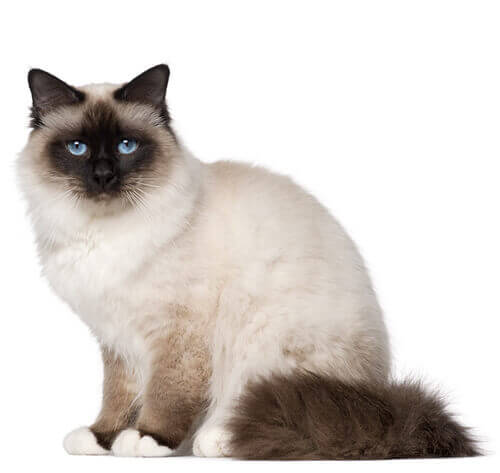
With her marvelous, social personality, the Birman doesn’t like being the only animal in the house. She is active and playful but quiet if you are busy. This healthy, long-lived breed has an outstanding semi-long silky coat that does not mat and a luxurious, long bottle-brush tail. Brilliant blue, almost-round eyes are prominent features of her sweet expression.
DID YOU KNOW?: A cat of mystery and legend, the Birman was the sacred cat of Burma, believed to be the companions of the priests of the temple.
The need-to-know
- Highly active and inquisitive cat
- Sociable and dependent cat
- Somehow talkative cat
- Average build cat breed
- Requires grooming everyday
- Needs some out-door space
- Great family cat
Personality

Birman cats are known as especially loving and affectionate breeds, having been bred as companion cats for many generations. They are docile and quietly spoken. Birman cats are sociable, smart and friendly cats, curious and people-oriented, but not too noisy.
History and Origins

Country of Origin: Burma/France
Other Names: : Sacred cat of Burma
While there is no clear record of the origin of Birman cats, one pair was taken to France around 1919, from which the breed became established in the western world. However, Birman cats were almost wiped out as a breed during World War II and were heavily outcrossed with long-hair breeds (mainly Persians) and also Siamese lines to rebuild the breed. By the early 1950s, pure Birman cat litters were once again being produced. The restored breed was recognised in Britain in 1965.
Nutrition and Feeding

Every cat is unique and each has their own particular likes, dislikes, and needs when it comes to food. However, cats are carnivores and every cat must obtain 41 different and specific nutrients from their food. The proportion of these nutrients will vary depending on age, lifestyle and overall health, so it's not surprising that a growing, energetic kitten needs a different balance of nutrients in her diet than a less active senior cat. Other considerations to bear in mind are feeding the right quantity of food to maintain 'ideal body condition' in accordance with feeding guidelines and catering to individual preference regarding wet or dry food recipes.
Other Information

Health and common issues
Some young Birman cats show evidence of impaired kidney function on blood tests – the significance is not certain but some may go on to develop kidney failure.
Best cat breeds for children
While this breed tends to be excellent with kids, each cat has a different personality based on training and life experience. Please consult the adoption organisation, if you are adopting, for details on a specific cats character.